Table of Contents
Varieties of Geraniums
When it comes to geraniums, they fall into two categories. They are either Pelargoniums from the Pelargonium genus or a Cranesbill, which is from the Geranium genus. The Cranesbill is the true geranium, although they are all commonly referred to as geraniums. The variety that are commonly planted in gardens and yards are the Pelargoniums, which can be found at most nurseries.
Pelargoniums
Within the Pelargonium category, there are five main varieties that are commonly planted in gardens and yards.
Zonal Geranium
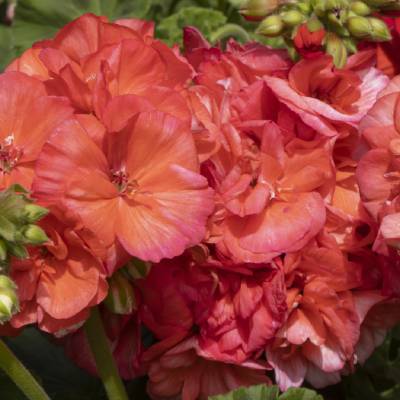
Zonal Geranium
The zonal geranium is named for the zone of darker color on the leaves. This color is more evident on some plants than others. They have succulent stems and light to dark green variegated leaves. The zonal geranium has a very pungent smell with blooms in red, white, pink, purple, orange, and occasionally yellow. For the most part they will grow to 24 inches tall and wide, but they are varieties that are only 5 to 8 inches tall.
Ivy Geraniums
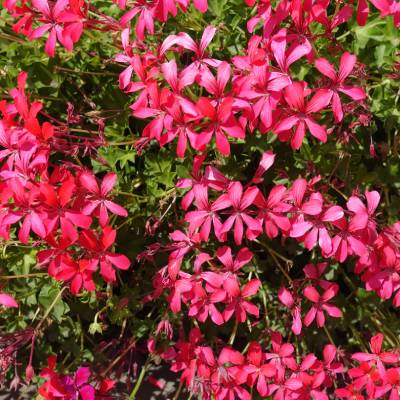
Ivy Geraniums
The ivy geraniums are named for their lobed leaves that can resemble ivy. They have bright green leaves that can reach up to 3 inches across. The blooms on the ivy geranium can have clusters of single or double flowers in colors such as red, pink, mauve, purple, and white. This variety is well suited for hanging planters and window boxes.
Interspecific Geraniums
The interspecific geranium is a beautiful hybrid of the above zonal geraniums and ivy geraniums. The flowers on this plant are large like the zonal geranium, but the leaves resemble the ivy trailing that the ivy geraniums have.
Regal Geraniums
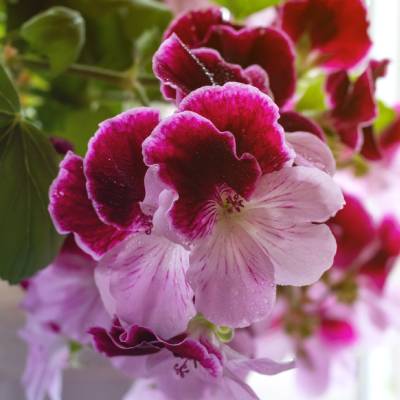
Regal Geraniums
The beautiful regal geraniums produce stunning flowers in occasional patterns of red, pink, purple, orange, white, and reddish-black. They have medium green leaves that are sometimes rounded, lobed, and even toothed at times. They will grow to anywhere from 12 to 48 inches in height.
Scented-leaf Geraniums
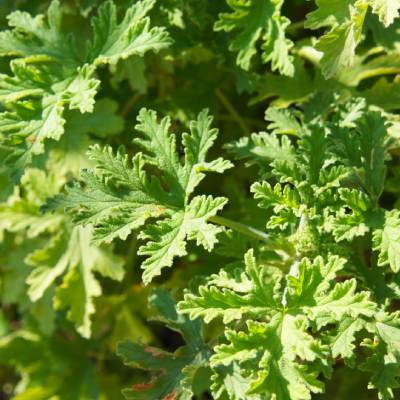
Scented-leaf Geraniums
The scented-leaf geranium is unique because their scent is only released when the leaves are brushed. They have medium green leaves that are occasionally variegated. The blooms that this plant produces come in mauve, pink, purple, and white colors. This particular type of pelargonium comes in almost 140 different varieties. When planted in the ground, this plant can grow quite large so it is important to provide enough room if it is not being planted in a pot.
Angel Geranium
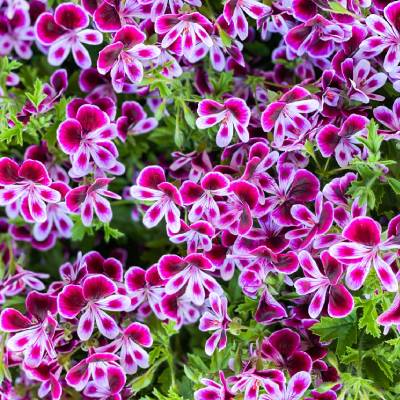
Angel Geranium
The angel geranium produces flowers with unique patterns. They come in shades of pink, purple, mauve, and white with leaves that are medium green. The leaves can be rounded, crinkled, and sometimes they are also scented. The angel geranium can range from 9 to 36 inches in height.
Cranesbill Geranium
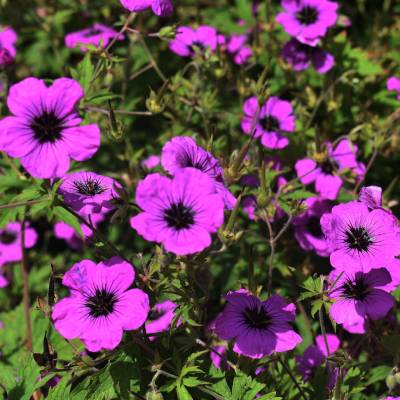
Cranesbill Geranium
There is only one type of true geranium and that is the Cranesbill. It is also known as the hardy geranium because it is hardy to temperatures as low as negative 20 degrees fahrenheit. The flowers on the Cranesbill are unique due to them being flat. The blooms come in all of the colors that the Pelargoniums come in such as pink, purple, white, mauve, and red. However, the flowers are not as bright and the leaves are not variegated.
How to Grow a Geranium Successfully
When to Plant
Geraniums are not naturally cold hardy unless you plant the Cranesbill. For Pelargoniums, you do not want to plant in the middle of winter when a freeze is possible. Cooler night temperatures will help to encourage budding so the best option is to plant them when the soil is around 60 degrees fahrenheit. This will usually be around early Spring.
Proper Hydration
Pelargoniums require an adequate amount of water to successfully grow. They need to be watered very thoroughly and deep into the ground.
The amount of water a Pelargonium actually requires will be dependent on the plant. This is going to require you to watch the plant itself. If you notice it starting to wilt, this is a sign that the plant needs more hydration. It is important to water more in the warmer months and then it can be cut back in the winter months.
Hardy geraniums require a lesser amount of water than Pelargoniums. They only need to be watered when the soil gets dry. If they are planted in an area with full sun all day long then they will require more watering than a plant that is in the shade a good portion of the day.
Soil Type
Pelargoniums will thrive in loose soil with a good amount of organic matter. They are going to grow the best in soil with a PH closest to 6.5. If the soil PH is below 5.5 then the geraniums will struggle to successfully grow and bloom.
If you notice your geraniums wilting or struggling, then it would be beneficial to do an at-home soil test. This will allow you to check the PH levels of the soil in your garden and know if you need to make adjustments to the soil. If your PH levels are too low, you can add agricultural limestone to the soil in order to increase the PH.
Hardy geraniums are not as particular about soil type. They can grow in almost any soil, but will also do best in neutral to slightly acidic soil. Limestone can be added to the soil to increase acidity if needed.
Drainage
Pelargoniums require proper drainage in the soil. Ideally you would want to have soil that retains moisture, but does not get too soggy. You do not want water to pool in the soil.
If you do not feel that you have properly draining soil, the best thing you can do is to add compost to your soil. You can use a 2 to 4 inch thick layer of compost and work it into the top 6 to 12 inches of soil. This will be beneficial for any type of soil.
Frequent Fertilization
Pelargoniums are a plant that do require frequent fertilization regardless of whether they are planted in the ground or in a pot.
A good schedule to follow with fertilization is to fertilize the plant every 4-6 weeks with a 15-15-15 fertilizer, which is specifically beneficial for geraniums. This will give them the proper balance of nutrients and help to reduce risk of growing issues.
Hardy Geraniums will not require any fertilization. They are so low maintenance that they can thrive with the yearly addition of compost, but not actual fertilization schedule.
Sunlight
Pelargoniums are a plant that thrive with a lot of sunlight. The ideal situation for them is to have 4-6 hours of full sunlight per day. If they will be in a filtered light area then they may need more time. An ideal planting location would be an area with South and West exposures to ensure they receive the direct sunlight they need.
Hardy geraniums can be grown in full sun to partial shade. They do not have as much of a sunlight requirement as the Pelargonium varieties do.
Grow Zones
Geraniums of the pelargonium variety will be mostly grown as an annual plant in zones 9-12. They are not hardy enough for extremely cold temperatures and will typically die when the weather gets cold. They are usually replanted each year. Some refer to them as tender perennials so there is the option to overwinter them prior to the cold temperatures.
The Cranesbill geranium or hardy geranium is considered a perennial. It can be grown in zones 3-9 and is very hardy against extremely cold climates. It will regrow when the weather warms up in the Spring.
Overwintering Pelargoniums
Although the Cranesbill can survive extremely cold temperatures, the Pelargonium variety will not. Some people will choose to overwinter their Pelargoniums in order to keep them alive through the winter.
If you have your Pelargoniums planted in the ground, you will need to remove them from the ground and plant them in a pot about 6 weeks before the first frost. If they are already in a pot, you can plant them in a new pot if you wish to do so at this time.
You will want to prune them back by about ½ to ⅔ at this time. If they have been living in the ground and are too large for a pot, you may need to trim them back by about ¾.
This is also the time to remove any diseased parts of the plant and treat for any pests if you notice any. Once this has been done, you will want to bring the plants inside for the Winter.
If you have a greenhouse, this will be ideal, but if not you can bring them into your house. The best place for them would be on a sunny windowsill or in front of a sunny window. As the weather starts to warm back up, they can be placed back outdoors in a sunny location to reacclimate and encourage new growth.
Disease & Pests
Although fairly easy to plant and manage, the geranium is susceptible to quite a few diseases. It is important to know the most common ones and how to treat them if the problem arises.
Alternaria Leaf Spot
This will be noted by dark brown, water soaked spots on the leaves of the plant. You may notice concentric rings on the leaf as well as a yellow halo around the spots. The best course of treatment for this is to apply a fungicide to the plant.
Bacterial Blight
This disease is unfortunately fatal to the plant. It will present in different ways on the plant, but it is commonly seen as circular or irregular shaped water soaked spots and lesions on the leaves. These will be tan or brown in color. Wedge shaped areas that are yellow in color can form with the wide part being in the leaf margin and the point touching a leaf vein.
Eventually this bacteria will take over the plant resulting in wilting, stem rot, and ultimately death of the plant. If your plant does contract bacterial blight, it is important to practice proper sanitation of gardening tools and to remove and dispose of the diseased plant immediately.
Botrytis Blight
Also known as gray mold, this disease is more prevalent in cold and damp environments. It is very evident that your plant has this because the blossoms will turn brown and eventually have the appearance of fungal spores covering them. These infected blossoms will usually fall off prematurely and anything that they touch will also grow the fungal spores as well.
It is important to remove any infected plant parts and dispose of them immediately. You can treat the plant with a fungicide as well at the first appearance of disease.
Pelargonium Rust
This may be one of the easier problems to identify. The leaves of the plant will develop reddish-brown pustules on the underside with yellow areas forming directly over the pustules on the leaf’s surface. The best treatment method is to remove the infected leaves and treat the plant with a fungicide.
Recent Articles

















